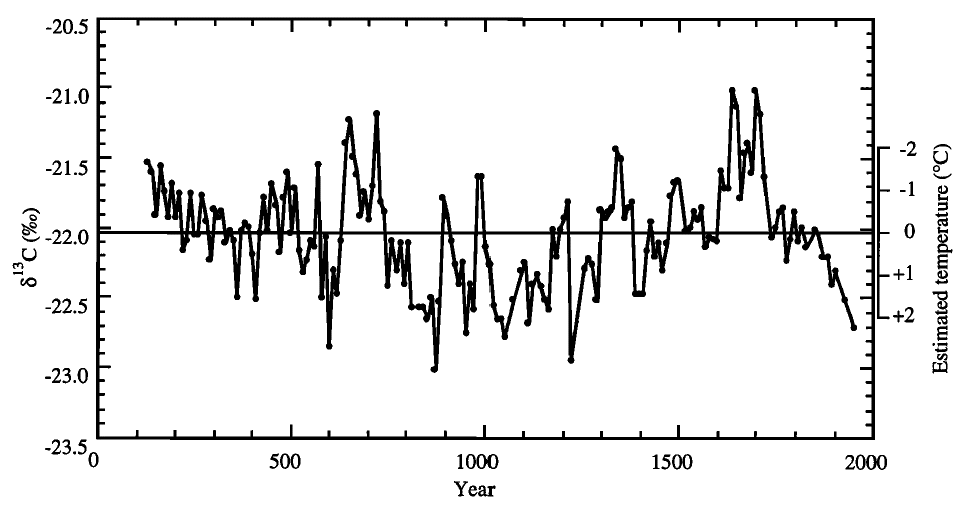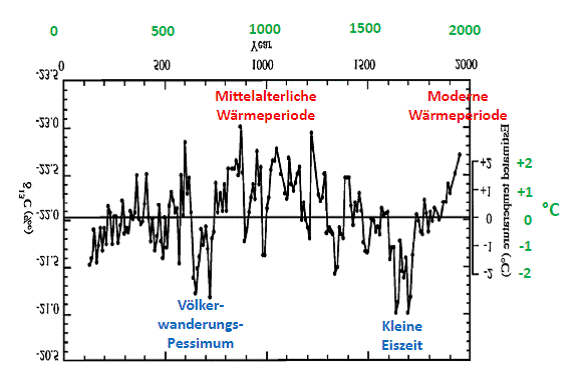Geologist Dr. Sebastian Lüning and Prof. Fritz Vahrenholt found a Japanese tree-ring temperature reconstruction from 1995, one that should have been heeded by the IPCC and Michael Mann before they took the world on a 10-year joyride in the stolen car of “climate science”.
 Medieval Warm Period and Little Ice Age found far, far away from the North Atlantic, before the IPCC took the world on a 10-year joyride.
Medieval Warm Period and Little Ice Age found far, far away from the North Atlantic, before the IPCC took the world on a 10-year joyride.
====================================================
Medieval Warm Period and the Little Ice Age as a local, North Atlantic phenomenon: Since when is Japan located in the North Atlantic?
By Sebastian Lüning & Fritz Vahrenholt
(Translated with permission, copyright English text NoTricksZone)Leading representatives of the IPCC tried for years to have policymakers and citizens believe the pre-industrial temperature history was more or less uneventful and was the ideal climate ondition that we should all strive to maintain. The warming of the 20th century, on the other hand, was completely unusual, something dangerous. However, as we now know, the page turned a few years ago and the notorious Hockey Stick chapter ended. The flawed curve was taken off the market and the Medieval Warm Period and Little Ice Age reappeared.
As is often the case in history, it is in retrospect difficult to comprehend how this historical joyride could have happened to begin with. It started at the end of the 1990s with a doctoral thesis by Michael Mann, and did not end until about 10 years later – thanks to the discovery of the scientific scandal by Steve McIntyre and Ross McKitrick (see the book The Hockey Stick Illusion by Andrew Montford). Today it is difficult to fathom how the main players and proponents of the Hockey Sticks are still able to act as experts and public opinion shapers.
One of the main excuses used back then was that the Medieval Warm Period and Little Ice Age in Europe and North America were local phenomena. At other locations on the planet the temperature anomalies were more than evened out (e.g. Stefan Rahmstorf, Gerald Haug). For years we had to listen to their tales and we had to trust these “specialists” for better or for worse. Moreover, we paid them with our tax money so that they could deal exclusively with the climate and carry out the tedious work all this entails.
However, anyone who knew a little something about the scientific literature soon began to wonder. The Medieval Warm Period and the Little Ice Age as a local North Atlantic phenomenon? A nutty claim. Naturally these characteristic temperature fluctuations had been described for other parts of the world. Here we report on a case study from Japan which had appeared in the Geophysical Research Letters already in 1995, in other words, in the years before the Hockey Stick episode.
In the early 1990s, Japanese scientists Hiroyuki Kitagawa and Eiji Matsumoto extracted eleven tree ring cores from cedars on the South
PacificJapan island of Yakushima. The cores contained tree-rings going back some 2000 years. The researchers determined the carbon 13 isotope values and found the delta-13-C values fluctuated in a characteristic manner (see Figure 1).
Figure 1: Temperature reconstruction for the South Japan island of Yakushima based on the C-13-isotopes. Attention! Temperature axis is inverted: cold temperatures are up and warm temperatures are down. Figure supplemented as to Kitagawa & Matsumoto (1995).
What did these fluctuations mean? Carbon-13 amount is influenced by a number of factors, among them temperature. The Japanese scientists calibrated the isotope development on trees of different elevations (and thereby temperature level) above sea level. Using this method they were able to come up with a formula that could be used for computing the temperature value using the isotope change. The results showed that temperatures over the previous 2000 years in South Japan fluctuated over a range of 5°C. The course of the temperature fluctuations takes on a shape that is very well known to us (see Figure 2). A clear millennium cycle is depicted. The cold period of the Migration Period, the Medieval Warm Period, the Little Ice Age and the Modern Warm Period are clearly recognisable. Moreover, this climate development is well documented in Japanese historical records.
Therefore, it is incomprehensible that with the clear Japanese data from the year 1995, the talk of a “local North Atlantic phenomenon” would go on for years after the data’s publication.
Figure 2: The same curve as Figure 1, but reinverted (up is warm, down is cold ) with the known warm and cold periods labelled. Völkerwanderungs-Pessimum = Migration Cold Period, Mittelalterliche Wärmeperiode = Medieval Warm Period, Kleine Eiszeit = Little Ice Age, Moderne Wärmeperiode = Modern Warm Period.
The two Japanese scientists even took it a step further. They carried out a detailed frequency analysis of their data and found characteristic cycles with periods in the range of several decades and centuries. Among others, they discovered a period of 187 years, which coincides with the known Suess/de Vries solar activity cycle. In a similar manner the 70 and 89-year Gleissberg-cycle was identified. In their results the authors saw a clear sign that the climate of the last 2000 years in southern Japan was predominantly influenced by solar activity fluctuations. The IPCC appears not to have been at all interested in the study. Indeed it did not fit with their climate catastrophe picture.







If climate science had the same rules and standards as the securities and financial instruments industry, the SEC would have hauled the IPCC insiders to court long ago. Blatant to no end!
Question
1 : Is Carbon 13 a good analogue for temperature ?
2 : Did Biffra et al use such a method or did they just use the size of the rings and extrapolate from there ?
Love that nosedive in temperatures circa 1300, it makes the historian in me turn cartwheels.
MBH98, the original hockey stick, was ring width only, postprocessed by Mann’s decentered PCA as documented by Steve McIntyre.
The major component of wood is cellulose, a compplex carohydrate – essentially a starch with really, really big molecules. The essential components are Carbon, Hyrodgen and Oxygen. ALL cellulose contains both C-12, C-13 and C-14. All except C-14 are stable isotopes, meaning you can derive a delta-C-13 ratio, AND because of the presence O-18 and O-16 a delta-O-18 ratio can be derived as well.
The chief means of separating isotopes of the same element is fractionation based upon the different masses of the distinct isotopes. This happens naturally as climate changes: when its warmer, it is easier for simple molecular compounds like H2O and CO2 with heavier isotopes (C-13 and O-18) to become airborn. When it cools, oceans take up CO2 with C-13 more rapidly than CO2 with normal Carbon (C-12). Similarly, water molecules with a heavier Oxygen isotope (O-18) will require more energy to transfer to a vapor state. That is simply basic physics.
There are some complicating issues. Certain plants (no trees) such as maize have alternative pathways for carbon metabolism and segregate C14, C13 and C12 differentially. When dating prehistoric plant material where the carbon may have come from a CAMS or C4 metabolism plant, the delta C-13 ratio is used to check and if necessary, calibrate a radio carbon date.
The essential point however is that tree rings contain material with the necessary isotopes to conduct multiple tests of growth rate sensitivity to temperature. The articles I have been able to locate such as test has been carried out consistently indicate that there is no correlation between growth and temperature, even in northern Finland. The key factor is available liquid water. One graph I have NOT so far been unable to locate is a correlation between ring width, stable isotope ratios, and temperature.
The major moves in this curve are reflected in a recent longterm Tibetan tree ring series, see http://wattsupwiththat.com/2011/12/07/in-china-there-are-no-hockey-sticks/
The 2485 year record is long enough to permit Fourier analysis on the first half replicate the temperature record of the second half and forecast a temperature decline from 2006 to 2068 that wipes out the warming of the last century.
It would be very interesting if the same analysis was done to the Japanese record.
You can do the frequency analysis by eye. The 350 – 400 year cycle is clearly visible.
Yeah, but my eyes don’t tell me if this series is calling for cooling from 2006 to 2062!
The Little Ice Age began about 1600. Add 400 years.
Paleoclimate studies may be of a high quality. Sometimes, I think that the hockey stick is a personal tragedy. Mann’s doctoral thesis would have been forgotten, if he would not have become the poster boy of the IPCC. Suppose, that you had to defend your doctoral thesis for the rest of your life and had to write after many years a book in order to justify it. Almost all articles and books reside in our museums, which is the consequence of a healthy science.
As a professional auditor, I remain puzzled how company directors can face prosecution for engaging in misleading and deceptive conduct by knowingly releasing reports to the market place that are seriously flawed if not fraudulent… yet the climate change charlatans (the IPCC and its assisting cabal of snake-oil salesmen scientists) can issue reports of greater consequence to the world, which are knowingly biased and flawed, and contain blatant errors and anomalies, but they still remain ‘untouchables’! There is something immoral and corrupt about that.
It’s just a question of time before it catches up to them. Eventually the wrong people are going to get mad.
century warming. Since that early century warming, temperatures have risen well-beyond those achieved during the Medieval Warm Period across most of the Globe. This has been confirmed by the National Academy of Sciences Report on Climate Reconstructions . Further evidence (Figure 1) suggests that even in the Northern Hemisphere where the Medieval Warm Period was the most visible, temperatures are now beyond those experienced during Medieval times.
[…] https://notrickszone.com/2012/06/17/hockey-stick-was-refuted-before-its-fabrication-study-ignored-ipc… […]
You do not need to bore into tree trunks to know about the Medeival Warm Period or the Little Ice Age, there is plenty of historical evidence everyone can read and understand.
Relying too much on positive sceience leads to ridiculous extensions, like the medical “studies” forecasting increases in crime because of rising temperatures. No one thought to cite the examples of warm countries, like Singapore, that have very little crime, and cold places, like Detroit, that rank pretty high in the FBI crime stats.
Nonsense cannot stand for too long. Reality usually has a way of dissolving it.